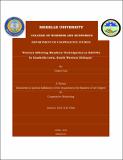| dc.description.abstract | The study was conducted in Gambella Town, South Western, Ethiopia with the objectives: (a) To study the extent of participation of members in SACCOs, (b) To identify the factors affecting members’ participation, and (c) To suggest suitable recommendations for improving participation of members in SACCOs.
To address the objectives of the study, both quantitative and qualitative methodologies were used in this study. Data were collected from primary and secondary sources. The primary data were collected through personal interviews from 115 members selected from six SACCOs by conducting formal survey using structured interview schedule and checklist for 4 FGD with 48 local community leaders and key communicators selected from the 5 kebeles to give their opinions which will help the SACCOs in the future.
Qualitative data were collected through focus group discussion with key community leaders and observations. This study used a two stage sampling procedure in which both purposive and random sampling techniques were used to select the SACCOs and sample respondents. Descriptive statistics such as frequency, mean, percentage, minimum, maximum and Pearson’s coefficient of correlation tools were used to analyze the data collected for the study with the help of SPSS-12.
Accordingly, in the analysis, the participation of members in the mobilization of their compulsory savings and the repayment of their loans were measured using time period such as before, on and after the specified period as well as never saved or repaid.
xii
And in this case if a member saved before or on the specified period of collection, he/she is called active participant. But if he/she saved after the specified time frame, or, if never saved, he/she is called passive and non-participant.
The same is true for the repayment of loans but the difference is that those who neither took loans nor repaid, they are also grouped under passive participants because the reason might be due to the inadequacy of the released loan.
Participation in the rationality also was measured by considering the utilization of their rights given to them to give their unbiased ideas on the agendas of their SACCOs. Hence, they are called active participants if they utilized their right and passive participants if they had never used their uniform right which is stated in the bylaw and other laws.
As far as members’ participation in the promotion of their SACCOs to introduce new members is measured by the times members used to promote the SACCOs. And here, if members engaged in the promotion activity regularly, they are called as active participants, if occasionally, they are called passive participants and if never engaged in, they are called non-participants.
The output of Pearson correlation analysis in table 4.19 indicates that sex is positively related with participation but statistically shown no significance value, age is negatively associated but not significant at either of the significance levels, family size only has positive relationship with members’ participation and significant at Pearson value of 0.05 level, religion also has positive relationship but insignificant, educational status negatively associated with members’ participation and also significant at P-value of 0.01 level and this output of educational status also works for occupation, savings mobilization, involvement in investment, loan repayment, awareness about cooperatives, business planning and promotion; but involvement in leadership and conflict resolution are positively related and significant; while the remaining variables such as monthly income, availability of other credit providing institutions, rationality and government interference shown no association and significant value.
xiii
Following the results in the descriptions of the variables, the researcher identified some factors that were playing a negative role in members’ participation. These factors include: differences in terms of sex, large family size, giving more emphasis to other businesses, low level of monthly income, members’ failure to mobilize their savings and to repay their loans before or on the specified time, lack of credit providing institutions, ineffective leadership, running the business without business plan and unexpected interference of the government in some of the affairs of the SACCOs. | en_GB |


